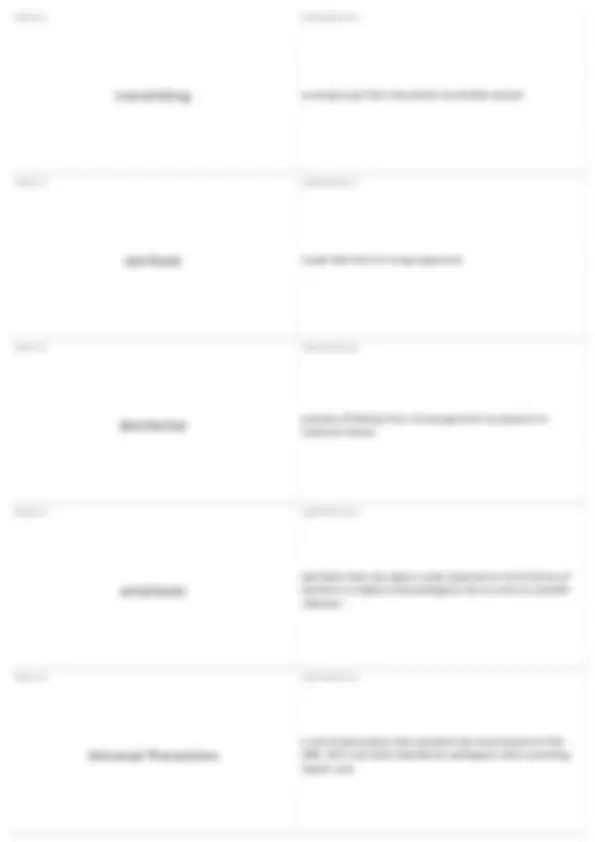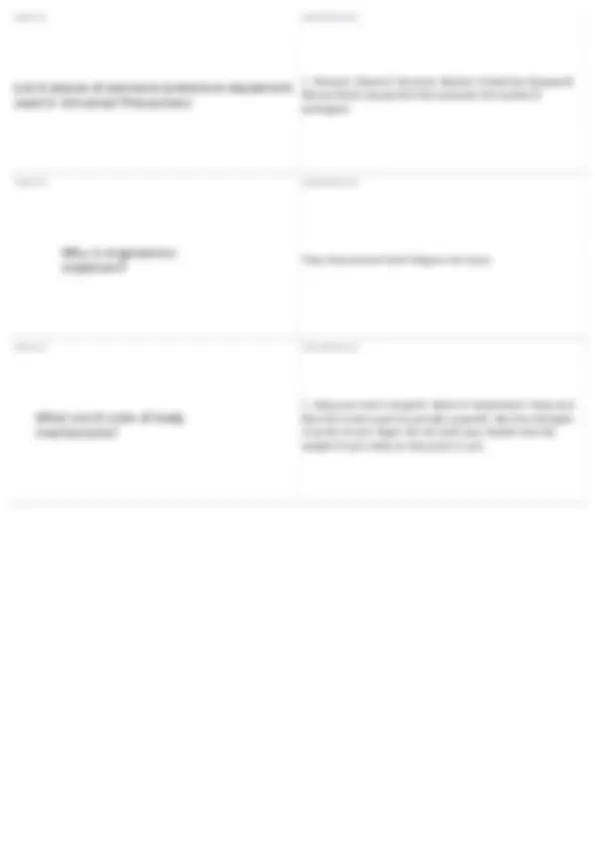Partial preview of the text
Download Ch. 9 part 2 | HEED 118 - Introduction to Health Care Systems and more Quizzes Health sciences in PDF only on Docsity!
spirochettes
slender, coil-shaped organisms
TERM 2
host
DEFINITION 2
the organism from which a microorganism takes
nourishment; the microorganism gives nothing in return and
causes disease or illness
TERM 3
salmonella
DEFINITION 3
a rod-shaped bacterium found in the intestine that can cause
food poisoning, gastroenteritis, and typhoid fever
TERM 4
toxins
DEFINITION 4
poisonous substances
TERM 5
enterotoxin
DEFINITION 5
poisonous substance that is produced in, or originates in, the
contents of the intestine
protist
an organism belonging to the kingdom that includes
protozoans, bacteria, and single-celled algae or fungi
TERM 7
contaminated
DEFINITION 7
soiled, unclean, not suitable for use
TERM 8
susceptible
DEFINITION 8
capable of being affected or infected/ the body can be
attacked by microorganisms and become ill
TERM 9
chain of
infection
DEFINITION 9
a chain of events, all interconnected, is required for an
infection to spread
TERM 10
bloodborne
DEFINITION 10
carried in the blood
transmitting
causing to go from one person to another person
TERM 17
sterilized
DEFINITION 17
made free from all living organisms
TERM 18
disinfection
DEFINITION 18
process of freeing from microorganisms by physical or
chemical means
TERM 19
autoclaves
DEFINITION 19
sterilizers that use steam under pressure to kill all forms of
bacteria on objects that pathogens live on and can transfer
infection
TERM 20
Universal Precautions
DEFINITION 20
a set of precautions that prevents the transmission of HIV,
HBV, HCV and other bloodborne pathogens when providing
health care
hazards
things that may cause harm to human, animal, or
environmental health
TERM 22
mandates
DEFINITION 22
orders of command
TERM 23
biohazard
DEFINITION 23
biological materials or infectious agents that may cause
harm to human, animal, or environmental health
TERM 24
abreast
DEFINITION 24
side by side
TERM 25
horseplay
DEFINITION 25
rowdy and childish behavior; acting inappropriately in a work
environment
ambulate
walk
TERM 32
load
DEFINITION 32
weight of an object or person that is to be moved
TERM 33
gravity
DEFINITION 33
natural force or pull toward the earth; in the body, the center
of gravity is usually the center of the body
TERM 34
crouch
DEFINITION 34
to stoop, using the large muscles of the legs to help maintain
balance
TERM 35
alignment
DEFINITION 35
keeping the body in proper position - in a straight line
without twisting
Where are microorganisms and viruses found?
In the air you breathe, on your skin, in your food, and on
everything you touch
TERM 37
What conditions affect the growth of bacteria?
DEFINITION 37
1. Food2. Moisture3. Temperature4. Oxygen5. Light6.
Dead/Living matter
TERM 38
List 5 ways to prevent the spread of
microorganisms and viruses
DEFINITION 38
1. Follow proper hand washing technique2. Ensure
employees are clean and neat3. Handle all equipment
properly4. Use sterile procedure when necessary5. Follow
Standard Precautions
TERM 39
List 3 ways by which bloodborne diseases are
accidentally passed
DEFINITION 39
1. By needle sticks contaminated with diseased blood2. When
infected blood comes in contact with eyes, nose, mouth, or
skin3. From infected mother to infant
TERM 40
Describe the purpose of Universal Precautions
DEFINITION 40
They prevent the transmission of bloodborne diseases


















